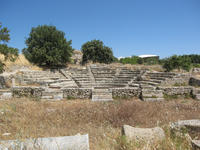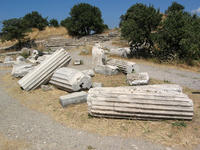You are in: Asia -> Turkey -> Archaeological Site ... , and traditional search or Image Gallery will yield results of this site only
Archaeological Site of Troy
| Site number: | 849 |
|
| Type of site: | Cultural | |
| Date: | 13th century BC | |
| Date of Inscription: | 1998 | |
| Location: | Eurasia, Turkey, Province of Çanakkale | |
Up to 75 images are shown here. Click on each for more details or on Image Gallery for more images.
Six official UN languages:
Arabic,
Chinese,
English,
French,
Russian,
Spanish
Other languages: Basque, Breton, Bulgarian, Catalan, Croatian, Czech, Danish, Dutch, Esperanto, Finnish, Galician, Georgian, German, Greek, Hebrew, Hungarian, Icelandic, Italian, Japanese, Korean, Lithuanian, Luxembourgish, Macedonian, Maltese, Norman, Norwegian-bokmål, Norwegian-nynorsk, Polish, Portuguese, Romanian, Serbian, Sicilian, Slovak, Slovenian, Swedish, Turkish, Ukrainian, Urdu, Venetian, Serbo-Croatian
Other languages: Basque, Breton, Bulgarian, Catalan, Croatian, Czech, Danish, Dutch, Esperanto, Finnish, Galician, Georgian, German, Greek, Hebrew, Hungarian, Icelandic, Italian, Japanese, Korean, Lithuanian, Luxembourgish, Macedonian, Maltese, Norman, Norwegian-bokmål, Norwegian-nynorsk, Polish, Portuguese, Romanian, Serbian, Sicilian, Slovak, Slovenian, Swedish, Turkish, Ukrainian, Urdu, Venetian, Serbo-Croatian
| Description: | One of the world’s most illustrious archaeological sites, Troy boasts a 4,000 year history. The famed archaeologist Heinrich Schliemann undertook the first excavations at the site in 1870. The site’s extensive vestiges, from a scientific point of view, are the most significant exhibition of the earliest contact between the civilizations of Anatolia and the Mediterranean world. Furthermore, the siege of Troy in the 13th or 12th century B.C .by Spartan and Achaean warriors from Greece, immortalized by Homer in his Iliad, has from that time on inspired eminent creative artists the world over. --WHMNet paraphrase from the description at WHC Site, where additional information is available. | |
| Troy (Greek: Τροία, Troia, also Ίλιον, Ilion; Latin: Troia, Ilium, Turkish: Truva) is a legendary city and center of the Trojan War, as described in the Epic Cycle, and especially in the Iliad, one of the two epic poems attributed to Homer. Trojan refers to the inhabitants and culture of Troy. Today it is the name of an archaeological site, the traditional location of Homeric Troy, Turkish Truva, in Hisarlık in Anatolia, close to the seacoast in what is now Çanakkale province in northwest Turkey, southwest of the Dardanelles under Mount Ida. A new city of Ilium was founded on the site in the reign of the Roman Emperor Augustus. It flourished until the establishment of Constantinople and declined gradually during the Byzantine era. In the 1870s the German archaeologist Heinrich Schliemann excavated the area. Later excavations revealed several cities built in succession to each other. One of the earlier cities (Troy VII) is often identified with Homeric Troy. While such an identity is disputed, the site has been successfully identified with the city called Wilusa in Hittite texts; Ilion (which goes back to earlier Wilion with a digamma) is thought to be the Greek rendition of that name. The archaeological site of Troy was added to the UNESCO World Heritage list in 1998. --Wikipedia. Text is available under the Creative Commons Attribution-ShareAlike License. | ||
| Source: | http://whc.unesco.org/en/list/849 | |
| Reference: | 1. UNESCO World Heritage Center, Site Page. | |






































